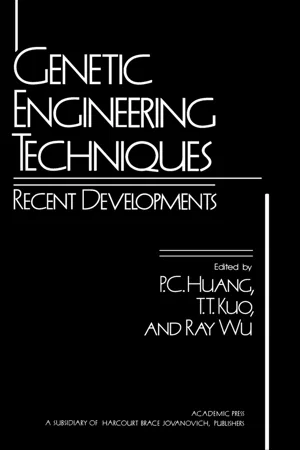
- 374 pages
- English
- PDF
- Available on iOS & Android
eBook - PDF
Genetic Engineering Techniques: Recent Developments
About this book
Genetic Engineering Techniques: Recent Developments covers the proceedings of the 1982 Genetic Engineering Techniques symposium held in Taipei. The book is organized into 21 chapters that discuss the application of recombination DNA methods in the study of DNA structure and DNA-protein interactions; the use of chemically synthesized genes in cloning; and gene expression. After briefly presenting the major strategies underlying genetic engineering technology and rapid method for sequencing DNA, the book examines the reaction mechanism of a multifunctional Type I enzyme and the organization and expression of the human adenovirus. The second section describes several approaches in analyzing transcriptional processes in prokaryotic and eukaryotic systems. This section also deals with cloning vectors and procedures of cDNA. The subsequent section describes a molecular approach to functional analysis of the influenza virus surface hemagglutinin; the transposition specificity for the transposons 3 and 4 elements; and the biological properties of human T-cell growth factor gene. The fourth section discusses the principles of hybridoma technology and its numerous applications to biological research. The remaining chapters of the book present laboratory courses designed to familiarize researchers with the principles and basic procedures in biological experiments. Genetic engineering researchers, agriculturists, and geneticists will find this book invaluable.
Frequently asked questions
Yes, you can cancel anytime from the Subscription tab in your account settings on the Perlego website. Your subscription will stay active until the end of your current billing period. Learn how to cancel your subscription.
At the moment all of our mobile-responsive ePub books are available to download via the app. Most of our PDFs are also available to download and we're working on making the final remaining ones downloadable now. Learn more here.
Perlego offers two plans: Essential and Complete
- Essential is ideal for learners and professionals who enjoy exploring a wide range of subjects. Access the Essential Library with 800,000+ trusted titles and best-sellers across business, personal growth, and the humanities. Includes unlimited reading time and Standard Read Aloud voice.
- Complete: Perfect for advanced learners and researchers needing full, unrestricted access. Unlock 1.4M+ books across hundreds of subjects, including academic and specialized titles. The Complete Plan also includes advanced features like Premium Read Aloud and Research Assistant.
We are an online textbook subscription service, where you can get access to an entire online library for less than the price of a single book per month. With over 1 million books across 1000+ topics, we’ve got you covered! Learn more here.
Look out for the read-aloud symbol on your next book to see if you can listen to it. The read-aloud tool reads text aloud for you, highlighting the text as it is being read. You can pause it, speed it up and slow it down. Learn more here.
Yes! You can use the Perlego app on both iOS or Android devices to read anytime, anywhere — even offline. Perfect for commutes or when you’re on the go.
Please note we cannot support devices running on iOS 13 and Android 7 or earlier. Learn more about using the app.
Please note we cannot support devices running on iOS 13 and Android 7 or earlier. Learn more about using the app.
Yes, you can access Genetic Engineering Techniques: Recent Developments by P.C. Huang in PDF and/or ePUB format, as well as other popular books in Biological Sciences & Botany. We have over one million books available in our catalogue for you to explore.
Information
Table of contents
- Front Cover
- Genetic Engineering Techniques: Recent Developments
- Copyright Page
- Table of Contents
- Contributors
- Preface
- Section I: THE BASIC TOOLS
- Section II: CLONING
- Section III: EXPRESSION
- Section IV: POTENTIALS
- Section V: SUMMARY
- SECTION VI: WORKSHOP
- Index